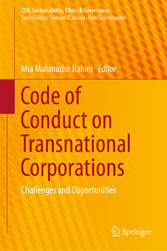Suche
Lesesoftware
Info / Kontakt
Code of Conduct on Transnational Corporations - Challenges and Opportunities
von: Mia Mahmudur Rahim
Springer-Verlag, 2019
ISBN: 9783030108168 , 194 Seiten
Format: PDF, Online Lesen
Kopierschutz: Wasserzeichen




Preis: 117,69 EUR
eBook anfordern 
Preface
7
Acknowledgements
9
Contents
10
Editor and Contributors
11
1 Quest for a Global Code of Conduct for TNCs—A Grim Tale
13
1 Introduction
13
2 Major Global Frameworks
14
2.1 The Draft Code of Conduct on Transnational Corporations
15
2.2 Tripartite Declaration of Principles on Multinational Enterprises and Social Policy
20
2.3 The OECD Guidelines for Multinational Enterprises
21
2.4 The Set of Multilaterally Agreed Equitable Principles, and Rules for the Control of Restrictive Business Practices
23
2.5 The Bilateral Investment Treaty
23
2.6 The Draft Norms on the Responsibilities of TNCs and Other Business Enterprises with Regard to Human Rights
24
2.7 The Global Compact
26
2.8 The Guiding Principles on Business and Human Rights
28
3 Conclusion
30
References
31
2 An ‘Instrument of Moral Persuasion’—Multinational Enterprises and International Codes of Conduct in the 1970s
35
1 Introduction
35
2 The Multinational Dilemma
38
3 Codes of Conduct
43
4 Aftermath
51
References
53
3 TNC Code of Conduct or CSR? A Regulatory Systems Perspective
56
1 Introduction
56
2 Background
57
3 Codes
57
3.1 What Is a Code of Conduct?
58
3.2 Codes and Law
59
4 Understanding Regulation
60
5 CSR as Regulation
61
5.1 Understanding CSR
62
6 Stand-Alone Code: ISO 26000 Case Study
63
6.1 Background
63
6.2 Analysis and Critique of the ISO 26000
65
7 Codes in Context: Success and Failure
67
8 A New Code?
68
9 Conclusion
70
References
70
4 Behavioral Dynamics and Regulation of Transnational Corporations
74
1 Introduction
74
2 The International Social Order Enables Predation
76
2.1 Institutions of the International Order Lack Sophistication
76
2.2 Powerful Actors Dominate the International Order
77
3 The Predatory Potential of a TNC
79
3.1 Behavioral Adjustment in Different Social Orders
79
3.2 Characteristics of the TNC and Its Home Social Order
81
3.2.1 The Predatory Nature of Products and Services of the TNC
81
3.2.2 The Economic Power of the TNC
82
3.2.3 The Strategic Importance of the TNC for the Home Social Order
83
3.2.4 The Power of the Home Social Order
83
3.3 Analysis of the Predatory Potential of a TNC
84
3.4 Example of Predatory Behaviors of TNCs
85
4 The Prey Potential of a Social Order
86
4.1 Power and Resilience of the Host Social Order
86
4.1.1 Governance Axis—Innovation Axis
87
4.1.2 Summary Diagrams of the Prey Potential of a Social Order
88
4.2 Assessment of the Prey Potential of Some African Countries
88
4.2.1 Governance: The Ibrahim Index of African Governance (IIAG)
90
4.2.2 Innovation: The Global Innovation Index (GII)
90
4.2.3 The Governance-Innovation Relationship for Africa
90
5 The Risk of Predation
93
6 Regulating TNCs Behavior Through SD and CSR
93
6.1 Crypto-Morality
94
6.2 TNCs’ Cost-Benefit Analysis of Predation
95
7 Conclusion
96
References
97
5 The UN Global Compact for Transnational Business and Peace: A Need for Orchestration?
99
1 Introduction
99
2 What is an IGO and What is the Theory of IGO Orchestration?
100
3 The Role of an Intermediary
101
4 Who Are the Targets?
102
5 What Kind of Rules?: Hard Law to Super Soft Law
103
6 What Are the Tools for Targets?
103
6.1 Case 1: Creating a Process of Guidance on Responsible Business in Conflict-Affected and High-Risk Areas: A Resource for Companies and Investors (UNGCO 2010)
105
6.2 Case 2: 25 June 2013 “Business for Peacebuilding” Conference
108
6.3 Case 3: Business for Peace Document (UNGCO 2013a)
110
6.4 Case 4: The Oslo Business for Peace Award
113
7 Concluding Note
114
References
119
6 Transnational Corporations’ Social License to Operate—The Third Facet of Corporate Governance
121
1 Introduction
121
2 Guidelines for TNCs
122
2.1 Approaches at the Domestic Level
123
2.2 Major Approaches at the International Level
124
2.2.1 UN Code for Transnational Corporations
124
2.2.2 OECD Guidelines on Transnational Corporations
126
2.2.3 ILO Guidelines on Transnational Corporations
127
2.3 Responsibility of Business to Uphold the Human Rights—UN Initiative
128
3 TNCs Towards Social Sustainability
129
3.1 Social Sustainability Through Mutually Accepted Trust-Based Guidelines
131
3.2 Social Sustainability Through ‘Social Licence to Operate’
132
4 Conclusion
137
References
139
7 Enforcement of a Global Code of Conduct on TNC’s Operations
141
1 Introduction
141
1.1 International Developments: Business and Human Rights
143
2 Current Domestic Law Enforcement
145
2.1 Case Study One—Anvil Mining Ltd
146
2.2 Case Study Two—Cisco Systems and China
147
2.3 Case Study Three—Broadspectrum Ltd and Asylum Seekers
148
2.4 Discussion
149
3 International Mediation and Arbitration
152
4 The Creation of an International Court
154
5 Conclusion: A Multi-pronged Approach
159
References
159
8 Converged Approach in Regulation for Socializing Transnational Corporations
164
1 Introduction
164
2 Corporate Social Responsibility and Its Principles
165
2.1 Corporate Social Responsibility
165
2.2 CSR Principles
168
3 Voluntary and Mandatory Modes for Implementing CSR Principles
171
4 Pro-business and Pro-regulation Arguments for Including CSR Principles in Corporate Self-regulation
173
4.1 Pro-business Arguments
174
4.2 Pro-regulation Arguments
175
5 The Converged Approach: Convergence of Pro-business and Pro-regulation Arguments
178
5.1 Conceptualisation of the ‘Converged Approach’
178
5.2 Application of the Converged Approach
183
5.3 Progress of the Converged Approach
185
6 Conclusion
187
References
188
9 Correction to: The UN Global Compact for Transnational Business and Peace: A Need for Orchestration?
194





